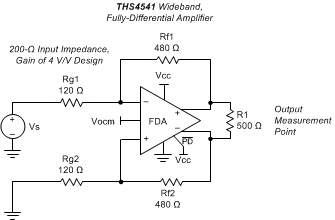SLOS375B August 2014 – February 2024 THS4541
PRODUCTION DATA
- 1
- 1 Features
- 2 Applications
- 3 Description
- 4 Device Comparison Table
- 5 Pin Configuration and Functions
-
6 Specifications
- 6.1 Absolute Maximum Ratings
- 6.2 ESD Ratings
- 6.3 Recommended Operating Conditions
- 6.4 Thermal Information
- 6.5 Electrical Characteristics: (Vs+) – Vs– = 5 V
- 6.6 Electrical Characteristics: (Vs+) – Vs– = 3 V
- 6.7 Typical Characteristics 5-V Single Supply
- 6.8 Typical Characteristics: 3-V Single Supply
- 6.9 Typical Characteristics: 3-V to 5-V Supply Range
-
7 Parameter Measurement Information
- 7.1 Example Characterization Circuits
- 7.2 Frequency-Response Shape Factors
- 7.3 I/O Headroom Considerations
- 7.4 Output DC Error and Drift Calculations and the Effect of Resistor Imbalances
- 7.5 Noise Analysis
- 7.6 Factors Influencing Harmonic Distortion
- 7.7 Driving Capacitive Loads
- 7.8 Thermal Analysis
-
8 Detailed Description
- 8.1 Overview
- 8.2 Functional Block Diagram
- 8.3 Feature Description
- 8.4
Device Functional Modes
- 8.4.1
Operation from Single-Ended Sources to Differential Outputs
- 8.4.1.1 AC-Coupled Signal Path Considerations for Single-Ended Input to Differential Output Conversion
- 8.4.1.2 DC-Coupled Input Signal Path Considerations for Single-Ended to Differential Conversion
- 8.4.1.3 Resistor Design Equations for the Single-Ended to Differential Configuration of the FDA
- 8.4.1.4 Input Impedance for the Single-Ended to Differential FDA Configuration
- 8.4.2 Differential-Input to Differential-Output Operation
- 8.4.1
Operation from Single-Ended Sources to Differential Outputs
- 9 Application and Implementation
- 10Device and Documentation Support
- 11Revision History
- 12Mechanical, Packaging, and Orderable Information
Package Options
Refer to the PDF data sheet for device specific package drawings
Mechanical Data (Package|Pins)
- RUN|10
- RGT|16
Thermal pad, mechanical data (Package|Pins)
Orderable Information
8.4.1.4 Input Impedance for the Single-Ended to Differential FDA Configuration
The designs so far have included a source impedance, Rs, that must be matched by Rt and Rg1. The total impedance at the junction of Rt and Rg1 for the circuit of Figure 7-3 is the parallel combination of Rt to ground, and the ZA (active impedance) presented by Rg1. The expression for ZA, assuming Rg2 is set to obtain the differential divider balance, is given by Equation 11:

For designs that do not need impedance matching, but instead come from the low impedance output of another amplifier for instance, Rg1 = Rg2 is the single-to-differential design used without an Rt to ground. Setting Rg1 = Rg2 = Rg in Equation 11 gives the input impedance of a simple input FDA driving from a low-impedance, single-ended source to a differential output as shown in Equation 12:

In this case, setting a target gain as Rf / Rg ≡ α, and then setting the desired input impedance, allows the Rg element to be resolved first, and then the required Rf to get the gain. For example, targeting an input impedance of 200 Ω with a gain of 4 V/V, Equation 13 gives the physical Rg element. Multiplying this required Rg value by a gain of 4 gives the Rf value and the design of Figure 8-1.

 Figure 8-1 200-Ω Input
Impedance, Single-Ended to Differential DC-Coupled Design with Gain of 4 V/V
Figure 8-1 200-Ω Input
Impedance, Single-Ended to Differential DC-Coupled Design with Gain of 4 V/VAfter being designed, this circuit can also be ac coupled by adding blocking caps in series with the two 120-Ω Rg resistors. This active input impedance has the advantage of increasing the apparent load to the prior stage using lower resistors values, leading to lower output noise for a given gain target.